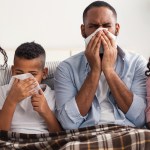Cornelia Vermeulen is a registered nurse and a mother of twin daughters living with autism. They will soon turn 16. Vermeulen says she knows first-hand what it is like to look for mental health services for children. Having struggled in “mainstream” schools, her children are now at a private school, where she says they get more attention.
She also runs Cornelia’s Care for Children, an organisation that helps other parents navigate their mental health journey with their children.
For Vermeulen, a big challenge is that schools and clinics are not well equipped to deal with children living with autism, ADHD or any other mental health disorder.
“There is a big problem at schools,” she says. “Some of the teachers are not well-educated to deal with these children. There is a big need to help these children at school. Because there is no help, [many] of them end up dropping out of school. You sit with a child who is old but they can’t even read and write. This can be solved if the teachers understood mental health challenges for children.
“Also, there is a huge need for special needs classes at schools; someone that will focus on these children and understand them and help them, because if they don’t get help, they just fall through the cracks and are lost in the system. That is a huge loss, not only for them but for the economy as well. They could have contributed something if they received the help and care they needed.”
South African Democratic Teachers’ Union spokesperson Nomusa Cembi says there is no special mental health training at schools. Cembi says teachers were calling for that long before Covid-19 but it is not happening. She says given the magnitude of the need, proper training of nurses for basic mental health services at primary healthcare level will be very helpful.
“Teachers have been asking for psychosocial services at schools and we have been talking to the department of education to liaise with the Department of Social Development but there is little to no services at all.
“Though the departments say they have programmes, schools are not seeing that. Training of healthcare workers at primary healthcare will be beneficial. Also, now with Covid, there is so much trauma and anxiety for both learners and teachers. Mental health training for teachers and basic training at primary health facilities will be a huge ammunition,” she says.
“The need for mental health services is dire. For now, if teachers do notice any mental health problems, they refer to the next level which will be your primary health facility.”
The departments of health, education, and social development had not responded to questions from Spotlight by the time of publication.
The numbers
A study that focused on high-income countries found that one in four to five young people in the general population suffers at least one mental disorder in any given year. Furthermore, the majority of adult mental disorders develop during childhood or adolescence when they could potentially still be prevented or identified and treated early.
“We do not have very good data on the various conditions that are experienced by young children, but issues like depression, anxiety disorder, ADHD, autism, and eating disorders are some of the prevalent mental health conditions in children and adolescents,” says Bharti Patel, national executive director of the South African Federation for Mental Health, speaking specifically about the situation in South Africa.
She says studies have found that due to the high rate of HIV, violence, substance abuse, and unemployment, our children and adolescents are more vulnerable to mental health conditions.
Patel says that, according to the World Health Organization, about 10% to 20% of young children, including adolescents (globally) experience some type of mental health condition.
Professor Petrus de Vries, the Sue Struengmann Professor of Child and Adolescent Psychiatry at the University of Cape Town (UCT) and director of the Centre for Autism Research in Africa, says children and adolescents present with a huge range of mental health disorders.
“There have not been any systematic studies in South Africa, but the rate is about 20% (one in every five children probably have a diagnosable and treatable mental health disorder). Mental health disorders are the number one health condition in those under 18, and 50 to 75% of adult mental health disorders have their onset in childhood or adolescence,” he says.
How mental health conditions present
De Vries says mental health problems can present in many different ways in children and adolescents and this can sometimes make it hard for parents, caregivers and peers to identify these problems early.
“One of the key markers is a change in the typical behaviour, activities, or interest of the child or young person. For example, a child may present as more withdrawn than usual, or less interested in schoolwork, saying everything is ‘boring’.
“Sometimes we see actual changes in school performance or in unwillingness to go to school. Sometimes children start to sleep more or less than usual, eat more or less than usual, or seem just to lose interest in the kinds of activities they would normally have enjoyed,” he says.
“Parents and caregivers usually become concerned when their children become more secretive or become confused in their thoughts. As you can see, these are all non-specific markers that may indicate an emerging mental health disorder.”
De Vries adds that there are sometimes more obvious worrying signs, such as when young people start to talk about death or dying or try to harm themselves.
What mental health services are available for children?
Patel says primary healthcare facilities provide basic health services to all, including young children and adolescents.
“The healthcare clinics in all districts are meant to provide mental health services as well as physical health services. Schools are also supposed to have support teams accessible where teachers can reach out for assistance with screening of children and adolescents for mental health conditions. Many NGOs are also accessible to communities where parents and young children can access information and counselling,” she says.
De Vries echoes this and adds that schools are great settings to support the mental health needs of children.
“It is even included in the integrated school health programme. In reality, teachers and school staff are keen and willing, but have little training, little knowledge, and little support,” he says.
In a study, nursing coordinator Stella Mokitimi and her co-authors explained that the national Child and Adolescents Mental Health (CAMH) policy framework of 2003 set out a three-tier model for CAMH services.
According to the study, depending on the complexity of the problem, the first point of contact for patients should be at Level 1 (informal and formal primary health services) and then move to Level 2 (mental health specialist teams) or Level 3 (child and adolescent mental health specialist teams). Patients will move between these levels based on the complexity of the problem, the type of assessment, and/or the type of intervention needed.
According to the Mental Health Policy Framework and Strategic Action Plan 2013-2020, the model of care for mental health issues is the same as described in the CAMH; however, for the framework, it starts with self-care, informal community care, then primary healthcare and then follows the tiers up from there.
But, as often is the case, having a healthcare policy in place and implementing that policy are two different things.
Patel says while the national mental health policy framework provides for the needs of children and adolescents, the policy does not provide for resource allocation.
“This has resulted in poor implementation of the policy at a provincial level,” she says.
“In provinces, there are no formalised mental health policy and action plans. In urban areas, there are still more clinics and hospitals available compared to rural communities. The country is failing to provide mental healthcare to young children and adolescents as there is no routinely gathered information from schools, clinics, or hospitals.
“Also, there are no provincial statistics collected to guide a systematic approach to mental healthcare for young children. Research has also shown that a lack of intersectoral collaboration has resulted in children falling through the gaps.
“The departments of health, social development and education all work in silos and this affects early identification and treatment of young children and adolescents with mental health conditions.”
Most recent policy has lapsed
Patel points out that the Mental Health Policy Framework and Strategic Action Plan 2013-2020 has lapsed and is in urgent need of a review.
The framework acknowledges that most mental disorders have their origins in childhood and adolescence. About 50% of mental disorders begin before the age of 14 years and the framework states that if diagnosed early they can be treated.
At the time the framework was published in 2013, the Eastern Cape had five mental health hospitals (the most of all provinces). KwaZulu-Natal had four mental hospitals while Gauteng, Western Cape and Limpopo all had three. Gauteng had 10 child and adolescent outpatients’ clinics, Free State had one, and Western Cape and KwaZulu-Natal had four each. But North West, Northern Cape, Eastern Cape, Mpumalanga, and the Free State had no child or adolescent outpatient clinics at the time – although things could obviously have changed in the meantime.
Access to specialist services
Apart from limited facilities, De Vries notes that there are only a handful of specialist services for children and adolescents with mental health disorders in South Africa.
“They are at tertiary level (in teaching hospitals) and are difficult to access because they are so limited. In one of our studies in the Western Cape, we estimated that probably no more than about 10% of children who needed mental health treatment actually accessed it.
“South Africa has only about 50 child and adolescent psychiatrists, and most [of them] work in the private sector (accessible only to a small proportion of families). The mental health of children and adolescents are therefore very poorly identified and treated in South Africa.”
He adds that for more than two decades experts have been saying that urgent action is needed.
Explaining the challenges of access to mental healthcare, De Vries says people in local communities often go to their local health clinic (which may or may not be able to help them with basics).
“Then they need to go to district mental health teams (where people have little knowledge and training in the mental health of children and adolescents).
“Only the lucky few progress to teaching hospitals where there are experts in child and adolescent mental health. For the last 20 years, experts have been recommending that we should have community child and adolescent mental health teams where families can connect to expertise in their own districts, connected to schools and social services and others who might be able to help,” he says.
“I think we are at a point where we need the voices of families and young people to say this is not acceptable and something should be done.
“However, virtually nothing has changed. If anything, [there are now fewer] resources and pressures or needs [are] higher. We are completely unable to meet the mental health needs of children. A lucky few receive good quality services, mostly in big cities.”
Covid-19 and children’s mental health
The Children’s Institute at UCT in collaboration with the Children’s Hospital Trust and the Michael and Susan Dell Foundation developed a series of advocacy briefs focusing, among others, on the impact of Covid-19 and the mental health of children. The briefs were released in August.
The advocacy brief on Mental Health and Wellness observed that there have been few studies on the mental health of children and adolescents during the pandemic.
“Much of the data we have comes from studies on the general population and these data show a rise in anxiety, with impacts rated as moderate to severe. In a long-term follow-up study of children and young people in England in 2020, more than 25% reported sleep disruptions, while almost 20% of children with a probable mental health problem stated that they were fearful of leaving the house because of Covid-19.
“Based on experience of other humanitarian crises and epidemics such as HIV, it is likely that there will be long-term and enduring mental health impacts on children, such as sleep problems, separation anxiety and aggressiveness,” stated the advocacy brief.
De Vries says he has not seen numbers from South Africa of mental health disorders during Covid-19, but there has probably been an increase.
“In European countries and elsewhere this seems to be the case. We have no reason to believe South Africa will be any [different],” he says.
Patel says: “Social isolation, ongoing lockdown regulations resulting in limited movement, closure of schools, halting of extracurricular activities, breaking down established routine, and also limited access to support systems have exposed the mental health vulnerabilities of young children and adolescents.”
She adds that parents and adults now working from home have created a home environment often filled with stress and anxiety as parents juggle work and family commitments.
“Parental support is extremely important to children and adolescents. Parents need to spend more time with children and adolescents explaining the pandemic and what is happening around us as we lose loved ones, teachers and friends.
“We also need to be mindful of the needs of children to remain in contact with friends via social media and allow them space and freedom to interact with peers.”
She notes that not all families have access to data, so alternate means of relaxation need to be found, like playing board games and getting children involved in preparing meals and spending fun time together.
But, reminds De Vries, “even in pre-Covid times the mental health of children and adolescents was a highly neglected area. Covid has just exacerbated all of it and in clinical settings, we are now dealing with very high levels of distressed young people and with very high rates of mental health disorders.” DM/MC
This article was produced by Spotlight – health journalism in the public interest.






















I cannot agree more. The youth is carrying a heavy burden. Not only are they struggling to deal with the direct effects of covid related changes such as isolation, more pressure at school and the general sense of insecurity with regards to their future (just to name a few) But their parents’ struggle with the realities of the pandemic are filtering down and are burdening the youth even more then before the start of Covid. In my counselling centre I see how Parents’ loss of income, unhealthy relationship to alcohol and drugs and the decreasing ability to provide a sense of safety for their kids is elevating the occurences and increasing the severity of adolescent (and pre pubescent) anxiety, depression and eating disorders (and many more). This is not based on research just anecdotal data form my practice here in the Western Cape.
Private practitioners are doing their best to cover where government is falling short, but there are only so many pro bono sessions a practitioner can afford to do. We need a better system
to deal with this problem. More primary counsellors skilled in basic practical counselling skills who are able to triage, flag and refer when necessary. On-the-ground agile counsellors are needed to contain and hold. And there needs to be a massive influx in funds to create inpatient facilities for under 18’s. For addiction, eating disorders and children at risk of harm themselves. The need is immense.